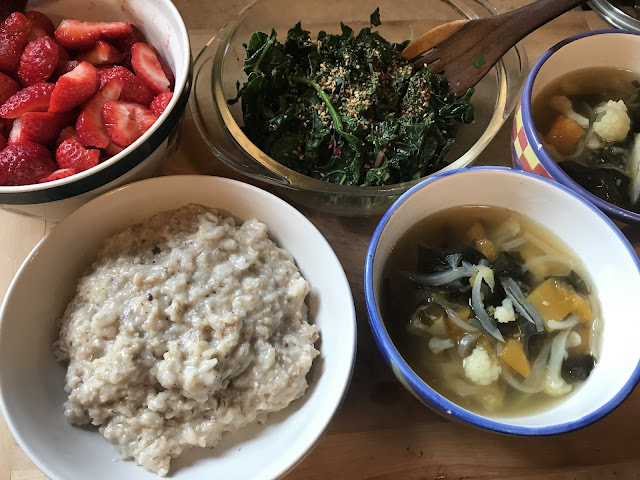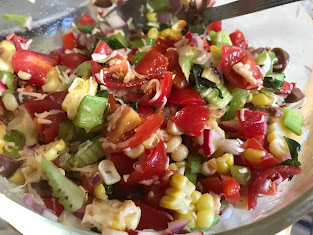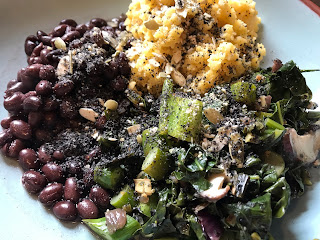How To Use Yin and Yang For Self-Healing, Part 3
Both macrobiotics and Chinese medicine offer a more nuanced perspective to diet and nutrition than Western approaches, which focuses more on macronutrients (protein, carbohydrates and fat), and isolated micro-nutrients, or as I refer to in my book, 'the nutritional resume of food.' This is fine, unless you need more specific insights to correct seemingly difficult to resolve issues or imbalances.
This begs the question(s): How will knowing about Yin and Yang help me? and How do we get imbalanced in the first place?
That's what I will address in this article!
I think William Scott Wilson, sums it up well in the introduction to his book, Cultivating Ch'i, A Samurai Physician's Teachings on the Way of Health, "How we integrate our lives with the transformation and maintenance of ch'i in order to attain harmony with its natural flow, however, depends on some knowledge of the two basic manifestations of ch'i, and how they differentiate into the myriad aspects of what we call "the real world." The two basic manifestations of ch'i he refers to here are Yin and Yang.
Kaibara Ekiken (1630-1714), the Samurai physician whose teachings Wilson has translated in Cultivating Ch'i is considered 'the grandfather of macrobiotics' which I feature in the next post, and in The MAP. One of the primary texts he relied on was The Yellow Emperor's Classic on Medicine, the earliest known manual on Chinese medicine dating back several thousand years, still in use by practitioners today. About the importance of understanding the cultivation of yin and yang ch'i (also qi, pronounced chee) it states,
"Listen, the four seasons and yin and yang are the foundations of all the Ten Thousand Things. Therefore, the sages nurtured their yang in the spring and summer, and their yin in the autumn and winter, in order to follow the very root of things. In this way...they followed the natural rise and fall at the gate of life and growth...
The person who goes against this root strikes at his very foundation and destroys its true force. Thus, yin and yang [are the] foundation of life and death. Going against them gives birth to disaster, but following along with them means not giving rise to severe disease. This is called Obtaining the Way."
Understanding how to use Yin and Yang for self-healing, therefore, is a prescription for living in harmony with nature, and all life, for longevity and thriving health.
Feeling Balanced?
How We Get Imbalanced
- We lack order, or a guiding principle.
- We eat out-of-season foods.
- We eat foods that are not balancing and nourishing for our individual constitution and condition.
- We eat too many foods and beverages from either extreme of being too yin or too yang.
- We don't use the right preparation techniques, including choosing too many cold or raw foods during the cold seasons, or heavy foods, and long cooking methods during the warm seasons.
- Imbalanced lifestyles, and/or high stress levels; unsatisfactory jobs or relationships.
- We don't trust ourselves, and do things counter to our true heart's desire and instincts.
We continuously and instinctively strive to achieve a Yin and Yang balance, or homeostasis, without realizing it. When we consciously choose to eat foods that are more centered (specifically whole grains, legumes, vegetables, and seeds) we maintain more even, balanced energy throughout the day, free of unhealthful cravings.
Eating from the extremes leads to more mood swings, food cravings, and uneven energy.
How To Use Yin and Yang for Self-Healing
To better understand how to use Yin and Yang for self-healing, we need a base-line diet as a starting point. I outline a foundational diet –– or pattern of eating –– similar to common patterns in successful cultures in my article, Universal Principles for Crafting a Healthy Balanced Diet. Macrobiotics and Chinese medicine recommend diets centered around principal and complementary food selections for health promotion and disease prevention which best proximate the same dietary patters of successful populations.
You can also read more about this in The MAP,
Many variables play a role in how well the foods you consume are nourishing you at a root level. As stated in Part 1 of this series, Chinese medicine views Yin as the Water element, which is associated with our Kidneys and Urinary Bladder paired organ system, and Yang as the Fire element, associated with the Heart and Small Intestine paired organs, along with two other channels not associated with an organ. Yin water and Yang fire keep each other in check. The Kidneys (and adrenals) are the root of the Yin and Yang of the entire body.
Each of the Five Elements interact in generative and controlling cycles. I have a chart of the Chinese Five-Elements, with more detail on my website.
Following is a brief list of important variables that will help you improve nutrient absorption, vitality, and yin-yang balance:
- Chew your food well! Especially whole grains.
- Eat in a relaxed environment, not while on the run or multi-tasking.
- Eat at consistent times, and eat enough to feel satisfied without over eating to support healthy functioning of your organs of digestion.
- Refrain from watching negative news stories or over stimulating videos during meal times.
- Purchase locally grown produce as much as possible, and the best quality foods you can budget.
- Be aware that your beliefs, attachments, and aversions to specific or entire categories of foods can affect your food choices, AND your digestion!
- Stress or anger will cause the Wood element (Liver & Gallbladder) to over act on / negatively impair your Earth Element (Stomach, Spleen & Pancreas), organs of digestion. Pause before eating if you are experiencing these strong emotions.
- Appropriate cooking techniques, including the use of the highly controversial oils, can help improve digestibility of foods, especially more gas-promoting foods like beans and legumes, but also brown rice and other whole grains.
When we eat the right foods, appropriately sourced, mindfully prepared ~ and thoroughly chewed ~ our digestion and absorption improves.
Our intuition will naturally guide us to the best choices once we are free from the grip of our sensorial cravings, limiting and false beliefs, and poor dietary habits. Imagine being free of unhealthful cravings and food obsessions! Food should nourish you, not control you!
You will discover that the more you eat the right foods, the more clear and intuitive you become as well!
Whole grains, legumes & vegetables comprise the trilogy of principal & complementary foods in traditional diets of cultures worldwide - Quinoa & Edamame Salad, L; Seasonal Summer Medley w/ Local Sweet Corn, Tomatoes & Cucumbers, R
Using Yin and Yang for Self-Healing - Where to Begin?
- Do you tend to crave sweets? If so, what types of 'sweets' are you typically drawn to? Many foods that people call 'carbs' or consider to be sweet foods are high in fat, not just sugar, and are typically very refined.
- Do you tend to crave more salty, savory foods?
- Do you prefer cold foods and beverages, and tend to consume more raw fruits, smoothies, and salads, icy cold drinks, or frozen foods? Or do you prefer more cooked foods, and warming spices?
- Do you eat when stressed or depressed?
- Do you eat a lot of rich, spicy foods, fried foods, high-fat dairy products and animal foods, or dry, crunchy snack foods?
- Do you tend to eat a really restrictive diet?
- Contrarily, are you more inclined to eat anything?
- Have you restricted whole grains or carbs in general for an extended period of time?



Your Symptoms & Cravings
- Damp-Heat in one of your channels, such as with shingles or food born Hepatitis A
- Spleen Qi Deficiency: tired, bloating after meals, loose stools, certain bleeding conditions
- Liver Yang Rising. such as with Hypertension, migraines, ruddy or flushed face, anger
- Yin Deficiency False Heat, seen with menopause symptoms such as night sweats, hot flashes and increased irritability
- Blood Deficiency, with Yin pale & low signs, listed below
How To Determine If You are More Yin or Yang
- Pale signs - pale pink under the eyelids and nail beds, pale tongue body, a white or no tongue coat.
- Low signs - low energy, moods, possibly low appetite, or bloating after meals
- Elimination signs - pale urine, no strong odors
- Emotions - tend to be more quiet, sad or emotional, fearful, low motivation, lack clarity, passive
- Cravings - prefer warm foods and beverages, warm clothing, tend to crave sweets
- Dietary history - may have consumed a lot more cold, raw foods, smoothies, salads, sweets, baked goods, coffee drinks, or drink a lot of water and other fluids all day
- Other - Tends to have a difficult time staying asleep or falling back asleep once awakened, may have pains that shift or change, possibly have spontaneous sweating, difficulty sweating, or night sweats (a Yin Deficiency), may have constipation or loose, wet stools; often feels cold, especially hands and feet, may have swellings and edema; skin breakouts that are more pale colored
- Redness - ruddy cheeks or reddish complexion, darker tongue body, possibly a yellow or dark or thick tongue coat, red lips, red in the whites of the eyes
- Moods & Emotions - tend to be more hyper or high energy, irritable, possibly tend to be easily angered or frustrated and impatient, more aggressive, clear and focused
- Elimination - usually more odorous, darker colored urine, possibly scanty
- Cravings - prefer cool or colder foods and beverages, and cooler climate
- Dietary history - may have a history of eating a lot of animals foods, especially eggs, red meat, poultry, dry salty snack foods, restrictive diets, spicy foods, or fried foods
- Other - Tends towards having heart and cardiovascular conditions, high blood pressure, hypertension, tension and pain, especially in the neck and shoulders, possibly migraines; may have constipation, easily over heat or tends to feel warm all the time, may have swellings or inflammatory conditions, or skin break outs that are red, raised and 'angry' or irritating
 |
| Steamed Peares w/ Brown Sugar or Fig Preserves nourish the Yin, good for dry cough, or as a simple fall dessert, especially good topped w/ Oat Milk Skyr! |
In Summary - How To Use Yin and Yang for Self-Healing
Despite differences between Macrobiotics and Chinese Medicine, perhaps the greatest utility of Yin and Yang ~ especially with respect to diet ~ lies in the following generalities applicable to both:
- TOO YIN - Consuming too many cold, raw foods and beverages, fruits or sugars will ultimately cause a condition of excess cold (considered too Yin in Macrobiotics), depending on one's constitution and geographic location. Excess cold, raw and frozen foods damages the Spleen Qi and weakens digestion. Those that live in a hot year round climate can better tolerate cold, raw foods.
- >>>Those who are 'too yin' (Yang Deficient in Chinese Medicine) tend to often feel cold or have cold hands and feet, have a difficult time getting going in the morning, often feel tired, lack mental clarity, focus and motivation, may have a difficult time staying asleep, and/or have weak digestion or constipation. These individuals will want to consume all or mostly cooked foods, and include more sodium and warming spices, such as cinnamon or dried ginger. Beverages should always be room temperature or warmer. Whole grains, winter squash, beans and seeds (especially black beans and black sesame seeds), and daily Miso Soups are also recommended to nourish the kidneys, the source of Yin and Yang within the body.
- TOO YANG - Consuming an excess of Yang, warming and building foods, especially animal foods, can lead to excess internal heat, ruddy complexion, tightness, and sluggishness due to a lack of optimal flow of blood and Qi. When we are too yang, we may over heat easily, and tend towards being more stiff, rigid, easily angered, and more competitive and aggressive. This can also lead to fatigue, and cloudy thinking, or poor recovery post hard exercise.
- >>>Consuming more salads, pressed salads, fruit and/or sweet or regular potatoes will quickly cool down an overly yang condition. Choosing more centered foods, such as whole grains and legumes, while cutting back on total animal foods consumed, and incorporating more greens, vegetables and fruits as desired and tolerated will create a better balance, longer-term. This must be balanced within the context of the rest of the diet.
If you are interested in learning more, or if you desire one-on-one support and coaching, contact me!
Top L: Bean Soup / Stew w/ 100% Whole Wheat Sourdough Bread; Top R: Miso Soup w/ Wakame Seaweed consumed daily as part of a healing diet for improving digestion, healing from chronic disease, and health maintenance
A Couple More Tips for Achieving Balance
- Pay attention to your thoughts: Repetitive negative thoughts, emotions and unhealthy lifestyle habits also affect your sense of balance. If you are not already doing so, consider spending at least 5-10 minutes each day letting go of all your thoughts and worries. Whether you prefer to sit in meditation, pray, chant, journal, or exercise, decide to commit to a daily practice that helps you get out of your head! In Chinese medicine, over thinking, worrying about future events, anger and stress all negatively affect the Earth element, or digestive functioning. I highly suggest a regular mediation practice, focusing on your breath. Thoughts will arise. Let them. The point is to learn to not engage them. Let them drift by like clouds in the sky.
- Pay attention to your symptoms: Your symptoms, moods and cravings are messengers helping you learn how to self-heal! Keep a food journal or log your meals on an app such as Cronometer.com. If you start to have cravings for sweets, for example, consider if you've either been eating too many salty condiments, are not getting adequate sleep or calories, or if you are eating too much protein-rich foods, and not enough whole grains and naturally sweet plant foods such as winter squashes, sweet potatoes, or some fruit. Adjust your diet, observe the outcome, and keep making small simple changes until you find your happy balance. Just remember that how you feel day to day is a result of many factors, including your thoughts and attitudes, not just your food.
- For those interested in jump starting a weight loss plan, or hitting the reset button: Try The Brown Rice Diet, with Gomashio or enough salty condiments, fermented vegetables, lightly steamed vegetables, and Miso Soups for 7-10 days. (You can choose other grains.) Watch my entire Brown Rice Diet Playlist on YouTube, and read my article, here, or contact me to learn more.SUMMARY OF MY EXPERIENCE ON THE BROWN RICE DIET (+ TIPS FOR DOING IT!)
Recipes
- Simple Japanese Dashi Broth & Miso Soup + Health Benefits of Seaweed
- Simple Macrobiotic Meals w/ Oat Millet Porridge, Miso Soup, Brown Rice w/ Peanuts, Pressed Napa Cabbage Salad
- Steamed Pears w/ Brown Sugar or Fig Preserves for Dry Cough
- Tofu Scramble Recipes
- Healthier, Refined Sugar-Free Sweet Potato Pie
- Gomashio Sesame Salt
- Best Brown Rice
- Brown Rice Sushi & Rice Balls & Brown Rice Porridge - Using Leftover Brown Rice
- Baked & Stewed Fresh & Dried Fruit Recipes
Learn More
- Yin & Yang According to Ancient Chinese Philosophy & Medicine, Part 1 of this 3-part series
- Yin & Yang According to Macrobiotics & The Similarities & Differences with/ Chinese Medicine
- Why Understanding the Concept of Principal & Complementary Foods Matters
- Universal Principles for Crafting a Healthy Balanced Diet
- Read about The Macrobiotic Action Plan, Your MAP to Greater Health & Happiness
- Healthy Savory Condiments
- Must-Have Healthy Savory Seasonings for Macrobiotic Cooking
- Is Western Science Superior to Taoist Science?, by Don Matesz
- You Are Not Your Thoughts, by Don Matesz
- Basic Meditation, by Don Matesz






















Comments
Post a Comment
Let me know what you think! I'd love to hear from you!